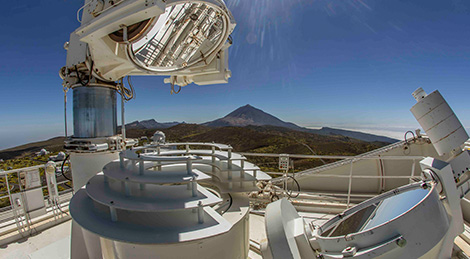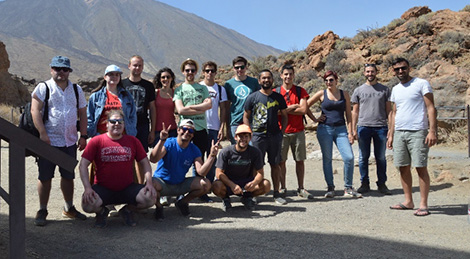Students place their heads above the clouds
Early this summer, 15 lucky students got to experience the life of a solar observer and spend time on the Islas Canarias to learn about solar astronomy.
The ‘Week above the Clouds’, which was the first SOLARNET-funded training event for the next generation of Solar Observers, took place on the 5-9 August, 2019 and provided the opportunity for students and young postdocs to learn about the running of an operational international solar observation facility. The school was organised by Dr. Nazaret Bello González (Leibniz-Institut für Sonnenphysik, KIS, Freiburg) and it brought together attendees from institutions across Europe. “Students and lecturers were very happy,” said Nazaret, “although a couple of days were intense and packed with activities, we enjoyed sunshine and clear skies and managed to keep above the clouds!”.
The training took place at the Solar Telescopes GREGOR and Vacuum Tower Telescope, El Teide Observatory, Tenerife, Spain. GREGOR is one of the largest solar telescopes in the world. Operations of the facility are delivered by a consortium of German institutions and are led by KIS. The 1.5 m telescope is designed to observe the solar photosphere and chromosphere at visible and infrared wavelengths. The students got first-hand experience of operations, taking over GREGOR for a day under the guidance of Dr. Christoph Kuckein (Leibniz-Institut für Astrophysik Potsdam (AIP), Potsdam) and Karin Geber (KIS). The cloudless skies meant they were able to make observations of the Sun’s atmosphere and then taught how to reduce the data for scientific analysis. Galina Chikunova, who has just finished her Masters degree at Skolkovo Institute for Science and Technology, Russia, was one those who attended the school. Her previous research has been on coronal mass ejections, although she enjoys working with optics – “I wanted to see one of the biggest solar telescopes and live like a true astronomer,” she said, “Every minute was perfect!”
Participants also had lectures and tutorials from world-experts, covering a breadth of topics suitable for analysing data obtained from the telescope – including solar spectroscopy, data calibration, Python and deep learning techniques. A particular highlight for all students was searching for their favourite lines in the solar spectrum using a high-resolution spectrograph on the neighbouring Vacuum Tower Telescope. “I wanted to attend the school to learn about spectropolarimetry and the latest advances in observation techniques,” said Jose Ivan Campos Rozo, a PhD student at the Institute of Physics/IGAM-University of Graz, Austria. Jose is studying the interaction between the plasma and magnetic fields in the lower solar atmosphere. “The most interesting thing I learned was the range of methods for the reduction and analysis of raw data. The workshop was really useful for my PhD.”
“It was great fun to show and demonstrate the Vacuum Tower Telescope and its spectrographs to the students. The students challenged me with excellent questions and enthusiastically worked on the various optical exercises we did!” adds Dr. Rolf Schlichenmaier (KIS), SOLARNET Project Coordinator.
The Summer School lasted 5 full days, including a guided excursion to the Parque Nacional de las Cañadas del Teide (Roques de García and Catedral). The attendees also got the chance to learn about the local area, learning about volcanic activity in the Canary Islands from I. Domínguez Cerdeña (National Geographic Institute, Spain).
The participants finished the week by promising to put their newly learnt skills into action, having agreed to work together to create a common observing proposal. They hope to submit for observation time on GREGOR as part of SOLARNET Transnational Access programme.
If you, or your students, would like to take part in a ‘Week above the Clouds’, then the training sessions will be held every summer for the next three years. This year, accommodation, food, and social events were completely sponsored by SOLARNET, while the students’ travel from their home institutions to the El Teide Observatory was partially subsided by SOLARNET travel grants. The next call for applications will likely open in the first half of 2020. There are only a small number of places, and given the success of the first event, it will likely be competitive. Keep on checking the SOALRNET project web page for details (https://solarnet-project.eu).
Written by Richard Morton (Northumbria University, UK)
Email: richard.morton@northumbria.ac.uk



